The early June garden is shaping up nicely, and I am finally starting to see the effects of last year’s work as new additions bloom for the first time and older plants mature into proper specimens.
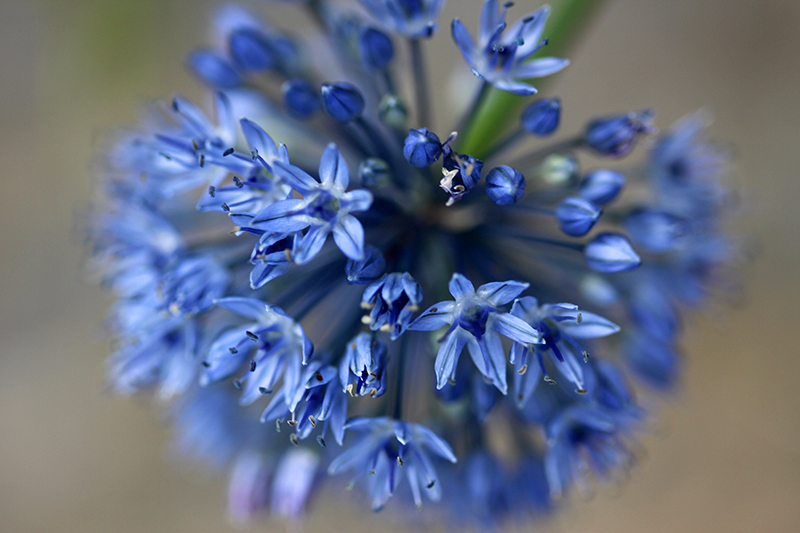
Allium caeruleum, a true blue color that’s hard to find among flowers of all kinds. I added a few to the garden last fall and they have bloomed with weak necks, which may be that they need time to beef up or they’re not happy with their locations. I hope it’s the former, as the color is awesome.

Deep red Asiatic lily, a big-box bag purchase that in four years has formed healthy, trouble-free (thus far), huge colonies in the garden.
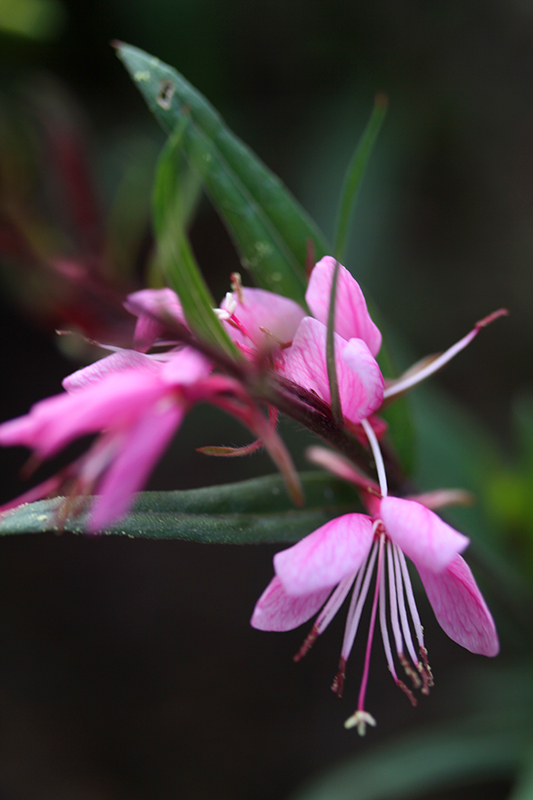
Pink gaura
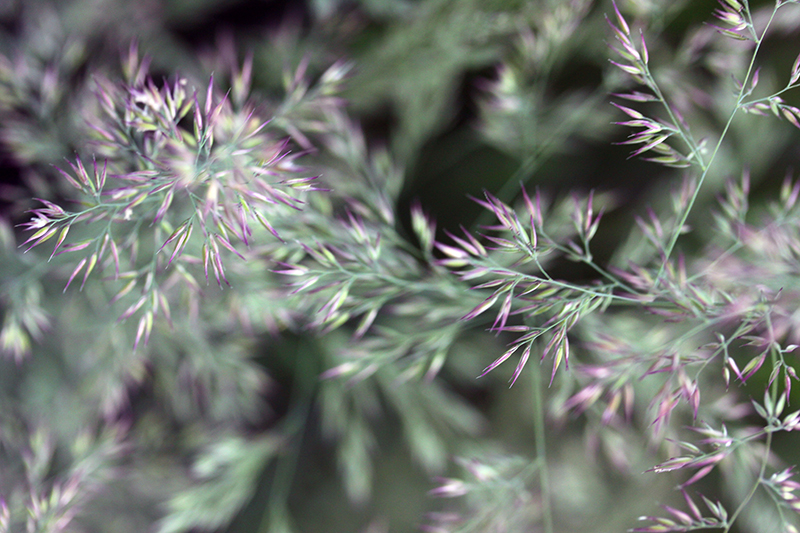
Ornamental feather reed grass, Calamagrostis acutiflora ‘Karl Foerster’ just heading up. Another standby that along with the lilies gives good height to the back of the June garden.

Geranium ‘Brookside’ bloom in front of Festuca glauca ‘Elijah Blue.’ I am really excited about these new hardy geraniums, or cranesbill, which I just put in all along the rock border of the garden. The idea is that they will spread and colonize these edges, and, I hope, keep the chickens from scratching all the mulch out of the garden into the yard. They’re gorgeous little plants, with blooms that are in life a bit bluer than in this picture.
My blue fescue has finally this year (I think it’s their third) matured into nice big plants that look like landscaping instead of errant pasture grass. I love how their color is almost an exact match for my porch floor.
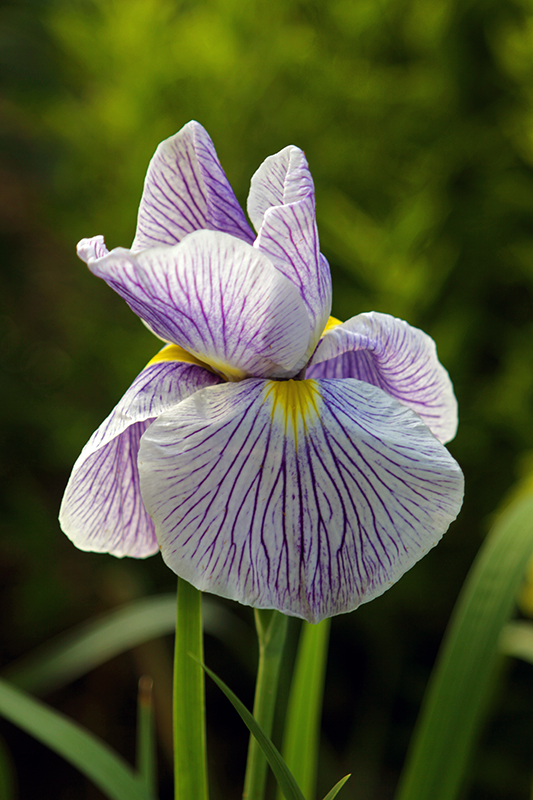
Iris ensata ‘Caprician Butterfly’. This Japanese iris goes through it’s bloom cycle so fast it’s hardly worth it. It spends one day blooming like this, then the next day the top petals drop down creating a flattened, donut-like bloom, and the next day the bloom is shriveled and brown. The bloom shape is not a look I love—I much prefer the upright flowers of the German and Siberian iris, but this plant was an experiment (aren’t they all!?) in growing irises that aren’t as susceptible to iris leaf spot as the German irises I removed from the garden.
In early August I was pretty sick of the house garden. Despite all the wonderful rain we’ve had this summer, which is unusual as we’re typically in a drought this time of year, the garden was looking tired. All I had going for me were some pretty garish purple phlox, which I appreciate as they bloomed for weeks and weeks.

However, with no other purple plants in the garden to play off, they looked lonely and out of place. And they were clashing with some ill-placed Crocosmia ‘Lucifer,’ above. All around town I kept eying beautifully blooming gardens, and from studying them I realized I hadn’t planted any mid-to-late-summer flowering perennials.
So off I went on a search for some of the hardiest of these standbys, including echinachea, agastache, coreopsis, monarda, and salvia, among others. It was late enough in the season that I managed to score some of these for 50% off, filling my car with ratty-looking twigs on faith that they had enough life left in them to establish in my garden.
To gain space for this minimakeover, I did some pretty major surgery on some of the existing garden plants. I dug out an entire colony of purple German bearded irises that nestled beside my blue atlas cedar. I was torn about it, as I’d rescued these as just a couple of tubers tossed in my brother’s backyard, and for the past few years they’ve bloomed beautifully each spring and grown into a sizable feature in the spring garden, playing beautifully with the Deutzia ‘Chardonnay Pearls,’ which bloomed at the same time.
 April 2013
April 2013
But this spring they were aflicted with iris leaf spot, and despite a couple of treatments, they weren’t able to shake it.
 August 2013
August 2013
Iris leaf spot won’t affect blooming until late in the game, but it makes the foliage look so ratty that I couldn’t stand it, especially in such a promintent place in the garden. And I am not interested in spraying anything in my garden to keep it looking good. So out they came.
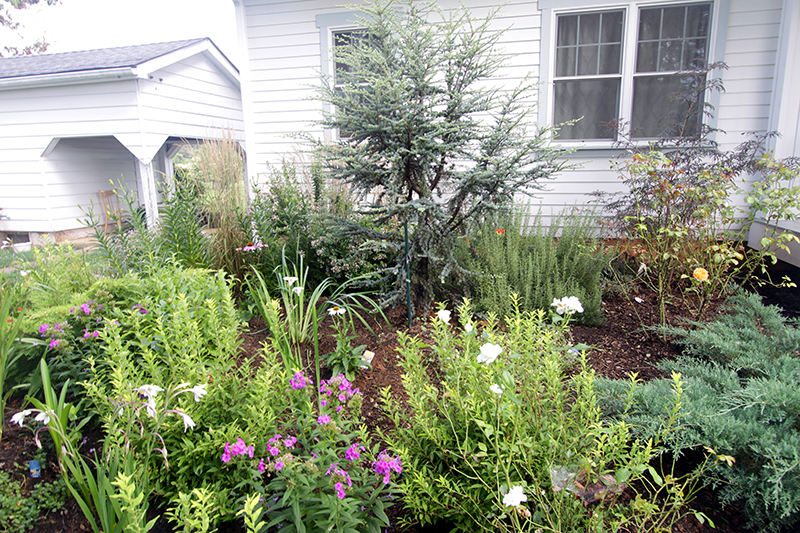
I replaced them with some echinacheas, which won’t give me the same spring bloom but should go crazy all summer. I chose Echinachea purpurea ‘Primadonna Deep Rose,’ for its relatively compact size and gorgeous flower color (not washed out and bland as I find some echinacheas to be) and ‘Primadonna White.’ I added a pot of Siberian iris (Iris sibirica ‘Ceasar’s Brother’). I know it’s a gamble to plant an iris back in the same soil afflicted with a soil-borne disease, but my trusted perennial guide Tracy DiSabato-Aust suggests that Siberian iris are less susceptible to iris leaf spot. I figured it was worth a gamble to return a purple-blue bloom to this place of honor. We’ll see. I also stuck another Siberian iris elsewhere, in unafflicted soil, and added a Japanese Iris (Iris ensata ‘Caprician Butterfly’) just for grins.
While I was on a tear, I also dug up another beloved bearded iris, ‘Precious Little Pink.’ This is a magical plant to me, and blooms in such a weird blue/purple/brown/pink color that’s just indescribable.
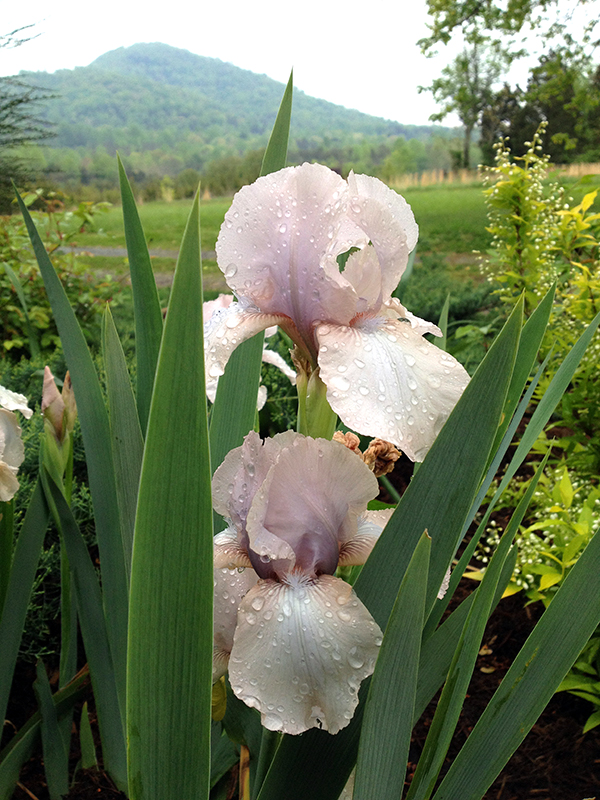 April 2013
April 2013
But it too was afflicted with iris leaf spot, so out it came. When it was out of the ground I discovered it also suffered from some rot and possible iris borer issues. And while I was in the mindset to dig irises, I rectified this unfortunate situation:
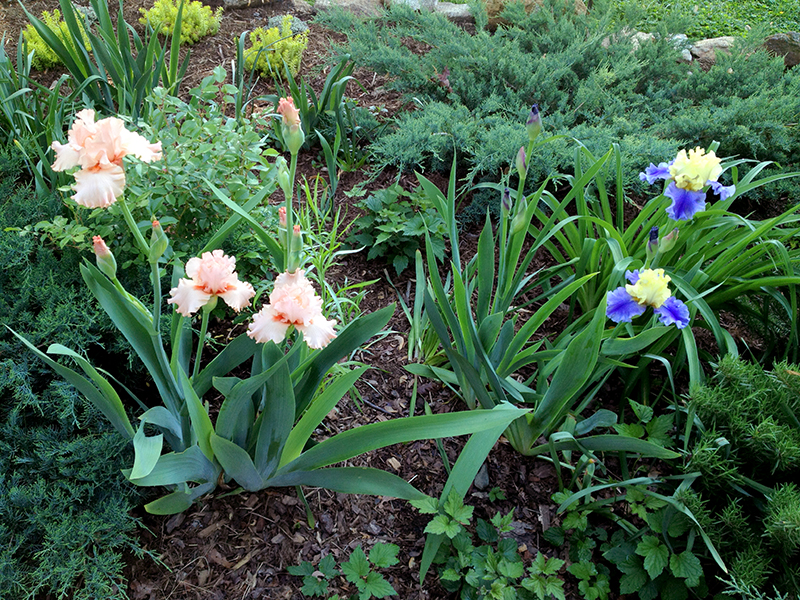
The horribly clashing blue and yellow iris (’Edith Wolford’) was relocated to the drainage ditch along the road, where I hope it will brighten the spring commutes of passers-by.
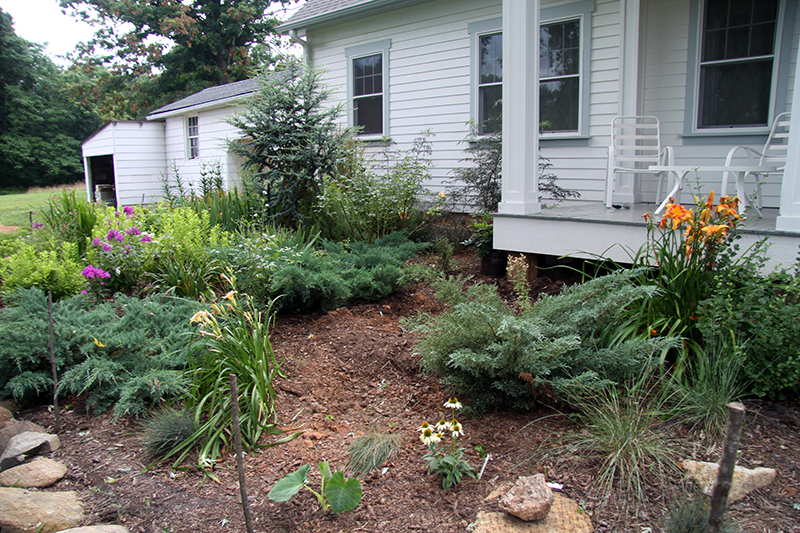
I also dug out all six of my daylilies, shown above along with the holes left from removing the Scotch broom. I had purchased the daylilies before the house was finished, again on deep clearance in the fall, and randomly plopped them in the ground to fill space. This year I finally realized that for the week or so that they bloomed, they took up too much space and looked boring. Plus, I am not a fan of bright orange and schoolbus-yellow blooms in this garden. So the daylilies had to go.

Looking better already! I added a few small evergreen shrubs to replace the Scotch broom. New additions are Nandina ‘Obsession,’ for red fall/winter color (near the porch corner) a relocated Deutzia ‘Chardonnay Pearls’, and a new plant to me, Distylium ‘Blue Cascade.’ (up front next to the elephant ears leaf). I’d been sold on the distylium’s virtues (uncommon deer, drought, clay and insect-resistant evergreen with small red winter flowers) while talking to a plantsman at our local fancy nursery, but he wanted $90 a bush. A few weeks later I found them at the local big-box hardware store for $25. Smaller plants, but that’s okay with me. I am curious to see how it does—it’s being marketed as a new foundation plant. Then I filled in around the new shrubs with a few perennials, including that purple spiky plant, Agastache ‘Bolero.’ It’s just gorgeous–with bronzy foliage and purple-blue blooms. The hummingbirds go nuts for it too. This an the new echinacheas help carry the purple phlox color across the garden.
I’ve still got all the removed iris and daylily tubers resting in the garage, and I plan to plant them back along the woodline. There they can bloom in the spring if they want and I won’t have to be worried about their disease-afflicted foliage later in the season.
It seems as though everything I planted got well-established. I realize things are planted pretty tight, but as you can see I am quite happy to thin and divide if the gardening gods bless me with successful growth. I can’t wait to see what the garden will look like as these flowering perennials begin to fill in and I find out if I was successful at addressing the issues I set out to fix.









 August 2013
August 2013



